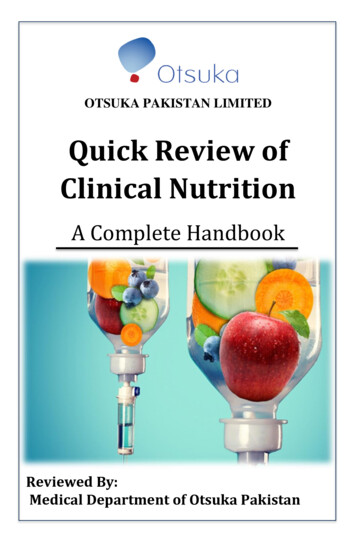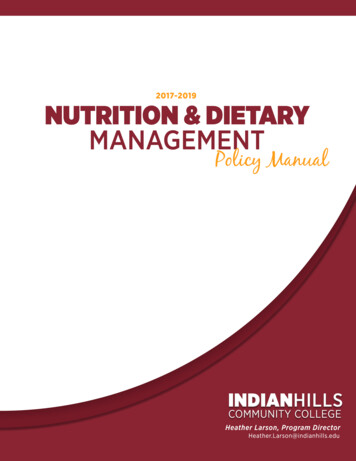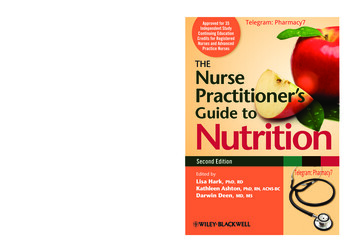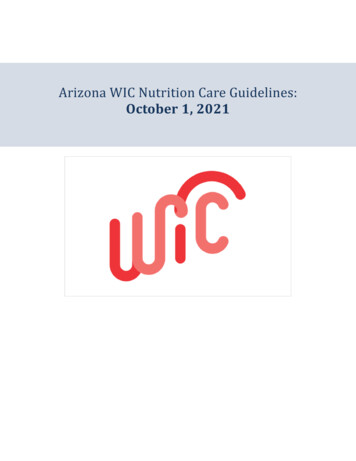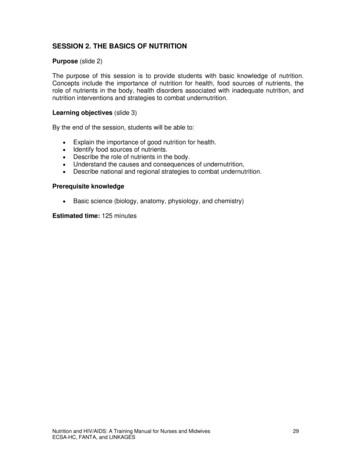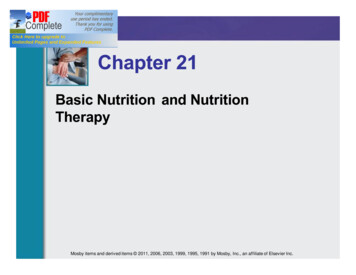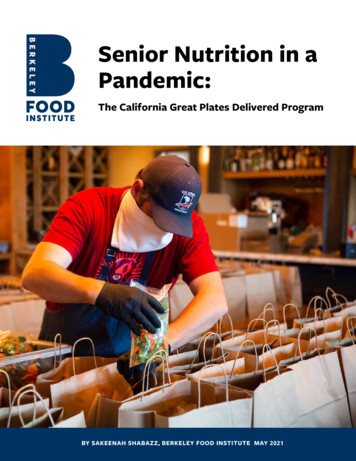
Transcription
Senior Nutrition in aPandemic:The California Great Plates Delivered ProgramBY SAKEENAH SHABAZZ, BERKELEY FOOD INSTITUTE MAY 2021Photo by Diane Villadsen.
This report was authored by SakeenahShabazz, UC Berkeley Goldman School ofPublic Policy MPP student. Born in San Diego,CA, Shabazz graduated from GeorgetownUniversity and previously worked for theCongressional Hunger Center and D.C. HungerSolutions, and was an AmeriCorps Memberfrom 2015-16 with City Year (Seattle, WA).Recommended citation: Shabazz, Sakeenah.“Senior Nutrition in a Pandemic: The CaliforniaGreat Plates Delivered Program.” BerkeleyFood Institute, University of California,Berkeley, May 2021. https://food. berkeley.edu/greatplatesdeliveredOverviewGreat Plates Delivered (GPD) is a home-delivered restaurant meals program that was piloted by GovernorGavin Newsom on April 24, 2020, amidst a global pandemic caused by COVID-19. Modeled after WorldCentral Kitchen’s Restaurants For the People initiative, Great Plates Delivered has the dual purpose of gettingprepared meals to isolated seniors and supporting restaurants across California. The program played aunique role in Governor Newsom’s broader economic and social response to the pandemic. The program isbeing managed at the state level through the California Governor’s Office of Emergency Services (CalOES),the California Department of Aging, California Health and Human Services Agency, and California ALL, withadditional funding from the Federal Emergency Management Agency (FEMA). At its peak, the program wasoperational in 40 out of 58 counties in California and still remains in effect in many.Participating Cities:Participating Counties:City of Citrus Heights, City of El Monte, City of ElkGrove, City of Lodi, City of Los Angeles, City ofMoreno Valley, City of Oakland, City of Parlier, Cityof Pasadena, City of Perris, City of Rancho Cordova,City of Rancho Mirage, City of Rosemead, City ofSacramento, City of Sanger, City of Seaside, Cityof Firebaugh, City of Montebello, City of Stockton,City of Long Beach, and City of Bell GardenSan Bernardino County, San Diego County, VenturaCounty, San Francisco County, Santa Cruz County,Contra Costa County, San Benito County, AlamedaCounty, Yolo County, Monterey County, San MateoCounty, Butte County, Los Angeles County, MarinCounty, Mendocino County, Nevada County,Orange County, Riverside County, Santa ClaraCounty
Table of ContentsExecutive Summary4How This Report Was Constructed6Senior Food Insecurity6Restaurant Worker and Food Business Challenges7Eligibility for Great Plates Delivered10Characteristics of Program Administration11Program Impact15A Deep Dive Into Four GPD JurisdictionsAlameda CountySan Diego CountySan Benito County16Los Angeles CountyMissed Opportunities and Unintended ConsequencesSenior Nutrition Services Before, During, and After the1718192021Pandemic22Recommendations / Considerations25Looking to the keley.edu/greatplatesdeliveredPhoto courtesy of Bloom Catering
Executive SummaryThrough qualitative interviews and surveys withadministrators, and public information requestsof CalOES, we have learned that the Great PlatesDelivered was ultimately successful at reaching its twoprimary goals: supporting isolated older adults withprepared meals and providing economic support torestaurants and meal providers across the state. Citiesand counties that operated the program encountereddifferent opportunities and challenges that werelargely determined by the size of the primary agencythat ran the program, their capacity to staff theprogram, the availability of meal providers, and theirability to work collaboratively with governmental,private, and community partners.Strengths of the program More than 8,000 workers wereemployed by meal providersparticipating in the Great PlatesDelivered program Minority-owned meal providerswere supported and overrepresented in some localities Direct financial support torestaurants and nutritious,consistent meals toparticipantsThe challenges were both anticipated andunforeseen and should be addressed if this programis to continue while California is under a state ofemergency, and potentially beyond. Through March2021, estimated spending on Great Plates Deliveredacross the state totaled 557,030,450 with thehighest spending in the following jurisdictions: Data were relatively easy tocollect and report to CalOES Most Great Plates jurisdictionsdid not have to limit thenumber of people who couldparticipate. Those that didonly did so initially and thenwere able to accept moreparticipants laterCounty of Los Angeles ( 91.6 million)County of Orange ( 66.8 million)County of San Diego ( 53.9 million)County of Riverside ( 44.7 million)County of San Mateo ( 42.8 million)County of San Francisco ( 40.8 million)City of Los Angeles ( 39.6 million)County of Ventura ( 37.8 Million)County of San Bernardino ( 33.7 million)City of Sacramento ( 15.9 million) The majority of GPD siteshave more than enough mealproviders Easy sign up and meal deliveryprocess for participants Some localities could offerculturally relevant foods toparticipants4
Challenges of the program Communication from FEMA on whether Great Plateswould continue to be funded was a challenge forthe majority of administrators. It was difficult tocoordinate meal deliveries with providers with only afew days notice in some cases. Reimbursement processing has been slow. As ofMarch 2021, 25 out of 40 localities have receivedreimbursements from FEMA and CDAA foradministrative and operational expenses.Thishas been cited as a reason by some Great Platesadministrators as to why their jurisdiction ended theprogram. It takes a significant amount of human capacity andcoordination to operate this program and some sitecould not provide that support without detractingfrom other essential operations in their city orcountyPhoto courtesy of Flapjacks Breakfast &Grill, used with permission of BenitoLink5
How This Report Was ConstructedThis report primarily uses publicly available data, a survey of city and county Great Plates Delivered Programadministrators, and four in-depth virtual interviews with administrators from the following jurisdictions:Alameda County, San Benito County, San Diego County, and Los Angeles County. The publicly available datawere accessed through two Public Records Act requests to the Governor’s Office of Emergency Service(CalOES), submitted on December 9, 2020 and March 21, 2021. The requests for information were fulfilled onDecember 21, 2020 and April 9, 2021.CalFresh data were gathered from the California Department Social Services (CDSS) Data Portal and data onthe Senior Farmers Market Nutrition Program (SFMNP) were gathered via a Public Records Act request tothe California Department of Food and Agriculture (CDFA) on March 29, 2021. The request for informationwas fulfilled on April 22, 2021. The Home-Delivered Meal Program (OAA ENP) data were gathered from theCalifornia Department of Aging (CDA) COVID-19 Response Data Dashboard.City and County administrators for the Great Plates Delivered Program were contacted via email to completea survey that captured their agency’s experience implementing and administering the program. Theirresponses were recorded through Google Forms. A full list of the survey questions and survey results is listedin the appendix. For the in-depth interviews, we sought to identify cities and counties that varied by region,population size, and jurisdictions where the program was still operating and where the program had ended. Indepth interview questions were tailored to each administrator, based on their responses to the Google Survey.Senior Food InsecurityEnsuring that seniors have access to nutritious meals at all times, but particularly during the pandemic isimportant. According to the California Department of Aging, there were 8.2 million older adults aged 60 andolder in the state, 18 percent of whom live alone. In a 2020 California factsheet from Meals on Wheels, 8 percentof seniors in California experienced some degree of food insecurity. A lack of access to nutritionally adequatemeals is associated with difficulty complying with medication routines, hospital readmissions, decreased mentalhealth, and other physical ailments. The Great Plates Delivered Program ensured that participating seniors hadtheir nutritional needs met by ensuring that meal providers supplied consistent, nutritious, and timely mealswhile the program was in operation.1California Department of Aging. CDA COVID-19 Dashboard - CDA’s Home Delivered Meals for Older Adults. https://aging.ca.gov/Data and Reports/COVID-19 Data Dashboard/#cda-meals2California Department of Aging. CDA COVID-19 Dashboard - Statewide Demographic Data on Older Adults, Fiscal Year NUV0zYeAlJo7upINg%3d%3d3Meals on Wheels of America. Delivering So Much More Than a Meal in California.California 2020 Factsheet. September -2020.pdf?sfvrsn c8a9b53b 24Aging in Place. The Facts Behind Senior Hunger - Illnesses Causes by Malnourishment. Updated April 2021. unger/6
Restaurant Worker and Small Food BusinessChallenges in the PandemicAs scientific awareness grew of the airborne nature of COVID-19 transmission,restaurants were increasingly identified as sites of heightened risk for bothworkers and customers. On March 16, 2020, Governor Newsom ordered allindoor dining establishments to close out of escalating concerns about the novelcoronavirus. Many small businesses, like catering companies, also temporarilyceased operations due to safety precautions and struggled financially during thepandemic. 5 As the pandemic worsened in April and May of 2020, there were fewstate or federal programs in place to support these businesses or their workers.5Bikales, James. Not Just Restaurants: Caterers are Suffering Even More. CalMatters. December22, 2020. ts-caterers-suffering-even-more/Photo courtesy of Robert Eliason, BenitoLink7
The first round of financial relief for California restaurants was the Paycheck Protection Program (PPP), madeavailable through CARES Act, which was signed into law on March 27, 2020. 6 Many business owners struggledto access these funds, especially small and locally-owned restaurants. In April 2020, 91 percent of PPP loans inCalifornia for large restaurants (300 or more employees) were approved, versus only 51 percent of loans forsmaller restaurants (100 or fewer employees). 7 There were also issues of transparency and racial disparities inwho ultimately was approved for a PPP loan. 8The second round of federal dollars to help restaurants was made available through the American Rescue PlanAct, signed into law on March 11, 2021. This time, 28.6 billion were earmarked for restaurants through theRestaurant Revitalization Fund. 9 The Biden administration also outlined a plan to more equitably disburse PPPloans to women and minority-owned businesses, small businesses, and businesses in rural areas. 10 Participationdata for the Restaurant Revitalization Fund is not available yet but it has the potential to make a significantimpact on local restaurants across California. On February 17, 2021, Governor Gavin Newsom also reachedan Immediate Action Agreement with leaders in the legislature to get more COVID-19 relief to Californians,including more funding and tax relief to small businesses, which could be beneficial to restaurants once madeavailable. 11Restaurant workers, especially line cooks, struggled to remain healthy and economically secure during thepandemic. According to a study recently published by the University of California, San Francisco, line cooks inrestaurants are at the highest risk of dying from COVID-19. 12 As of May 2021, restaurant workers that filed theirtaxes in 2019 should have received two stimulus checks from the federal government. Only those who lost theirjobs, and had a W-2 from work, could qualify for unemployment insurance. Many restaurant workers wereineligible or found these financial supplements insufficient.6Coronavirus Aid, Relief, and Economic Security Act of 2020. United States Congress. r748enr.pdf7Sierra, Stephanie and Lindsey Feingold. The French Laundry got more than 2.4M in PPP funding; 17x more than average Bay Arearestaurant. ABC7 News. December 15, 2020. p-loan/8806467/8Morel, Laura et al. Businesses in majority-white communities received PPP loans at higher rates, analysis shows. The Los AngelesTimes. May 1, 2021. U.S. Small Business Association. Restaurant Revitalization Funding Program. April 28, 2021. %20as%20of%204.28.21-508 0.pdf10U.S. Small Business Association. Fact Sheet: Changes to Paycheck Protection Program by Biden-Harris Administration IncreaseEquitable Access to Relief. March 9, 2021. dministration-increase-equitable-access11Office of Governor Gavin Newsom. Governor Newsom, Legislative Leaders Announce Immediate Action Agreement for Relief toCalifornians Experiencing Pandemic Hardship. February 17, 2021. mic-hardship/12Chen, Yea-Hung et al. Excess Mortality associated with the COVID-19 pandemic among Californians 18-65 years of age, byoccupational sector and occupation: March through October 2020. University of California San Francisco - Institute for Global HealthStudies, Department of Epidemiology and Biostatistics, and the Department of Medicine. January 22, 2021.8
Photo courtesy of BenitoLinkFor restaurants that remained open, workers faced the risk of COVID-19 infection while preparing and deliveringfood to Californians who could afford to shelter at home. To support restaurant workers, groups like theRestaurant Opportunities Center provided direct cash assistance to workers. 13 The James Beard Foundationstarted the Food and Beverage Industry Relief Fund in April 2020 to support small, independent restaurants thatemploy fewer than 100 people and promote a fair, safe, and respectful workplace. 14In this distressed environment, the Great Plates Delivered Program served as a financial lifeline for bothrestaurant owners and workers. According to data from CalOES, the Great Plates Delivered Program helped tokeep more 8,000 restaurant and food business workers employed during the pandemic. 15 Additionally, almost athird of all localities reported that the majority of their meal providers were minority-owned businesses. 16 Mealproviders can be reimbursed up to 66 per day for three meals a day, based on the per-diem rate set forth byFEMA. This rate doesn’t cover all costs associated with running a business, but some found it enough to stayopen during the pandemic while serving seniors in their respective communities.13Restaurant Opportunities Center. National Direct Financial Assistance. support/James Beard Foundation. Relief Fund Application. #: :text ng%20out%20of15The data for the number of workers that remained employed by meal providers were requested via Public Records Request toCalOES. The number was self-reported by the meal provider to the agency in the section titled, “Total number of staff membersemployed by your jurisdiction’s currently participating meal providers (self- reported by local jurisdiction)”. As of April 9th, 2021, thetotal number was 7,946 but this was undercounted because not all localities reported this metric.16The data for the number of minority-owned businesses serving as meal providers were requested via Public Records Request toCalOES. Identity was self-reported to the agency in the section titled, “Average percentage of currently participating meal providersidentifying as “minority owned” (self-reported by local jurisdiction). As of April 9, 2021, 27 out of 40 GPD sites reported these data toCalOES.149
EligibilityThe Great Plates Delivered Program hasstrict participation guidelines based onage, income, housing arrangement, andother criteria. The applicant must meet thefollowing guidelines:Be 65 years of age or older OR be aged60-64 and have had a positive Covid-19diagnosis, possible exposure, or beconsidered high-risk according to CDCguidelines.Live alone or with a program eligible adult.Not be receiving assistance from a stateor federally funded nutrition assistanceprogram, like CalFresh or Home DeliveredMeals.Have difficulty accessing and preparing one’sown meals.Earn less than 600% of the federal povertylimit (have an income between 25,000 and 76,560). Applicants used self-attestation toverify income.Live within a city or county participating inthe program.10
Characteristics of Program AdministrationTo serve as a Great Plates Delivered site, the city or county must identify a local administrator and handle theindividual enrollment of clients. Each jurisdiction is also responsible for initially funding the program, with thepossibility of reimbursement from the state and/or federal government. Costs per participant are capped at 66 per day, for three meals provided. Local administrators are also responsible for reporting data on a twiceweekly basis to CalOES on metrics including number of requests to enroll, number of meals provided and datesdelivered, average length of participation, and more.When the program first started, the FEMA Public Assistance Program reimbursed 75 percent of eligibleexpenses associated with implementing and running the program. To participate, a jurisdiction must contributea 6.25 percent cost share, while the State of California covers the remaining 18.75 percent, administered throughthe California Disaster Assistance Act (CCDA). CCDA funds are used to reimburse local governments that havespent money on certain emergency activities in response to a state of emergency, like setting up an emergencymeal program during a pandemic. 17 As of January 21, 2021, FEMA may now reimburse up to 100 percent ofeligible costs related to operating the program, through September 30, 2021. 1817California ALL. Great Plates Delivered Program Guidance. Administration - Funding. Page 5. Revised March 1, 2021. elivered-program-guidance.pdf18The White House. Memorandum to Extend Federal Support to Governors’ Use of the National Guard to Respond to COVID-19 andto Increase Reimbursement and Other Assistance Provided to States. Briefing Room - Presidential Actions. January 21, 2021. nce-provided-to-states/11
Restaurants that wish to participate in the Great Plates Delivered program canapply through CalOES and or directly through the locality. Approved restaurantsmust follow strict nutritional guidelines for breakfast, lunch, and dinner meals,along with food safety procedures for preparation and delivery. Meal providersthat work out of commercial kitchens or create pre-packaged meals are alsoeligible to participate in the Great Plates Delivered Program.Local agencies work with meal providers to arrange meal deliveries to GPDparticipants. Typically, a list of participants will be given to the restaurant’s pointof contact on a Thursday or Friday to let them know how many meals shouldbe prepared for the following week. Over the weekend, restaurants and mealproviders are able to procure the food items necessary to prepare the meals.Reimbursements to restaurants can be processed on a weekly, biweekly ormonthly basis, depending on their agreement with the coordinating agency.To deliver meals to participants, some jurisdictions, like San Diego Countyand Los Angeles County, required all meal providers to also deliver meals toparticipants. Other places, like San Benito County and the City of Sacramento,utilized paratransit services, along with some restaurants making meal deliveriesthemselves. Gig-based platforms and private companies, like Doordash and GoGoGrandparents, were used in the City of Citrus Heights and in Alameda County todeliver meals to participants. The latter example, GoGo Grandparents, a ride-hailintermediary, was procured by Alameda County to also manage a call center forscheduling meal deliveries and handling quality assurance issues.Operating the Great Plates Delivered Program requires a great deal ofcoordination across multiple local agencies. The most common agencies thatwere central to coordination of the program were Area Offices on Aging, Officesof Emergency Services and Departments of Social/Human Services. Somelocations also worked with Chief Executive Office’s and their local Chambers ofCommerce. Partnerships with private agencies also proved useful in coordinationefforts, such as GoGo Grandparents in Alameda County.12
Statewide Great Plates Delivered participation and spending through March 2021.American Community Survey (ACS) Population Estimates (July 1, 2019) andCalifornia Health Interview Survey 2018. Food Insecurity Rates from Meals onWheels 2020 California Fact Sheet.CalFresh data reflect a Point-In-Time count conducted in July 2020 by theCalifornia Department of Social Services. SFMNP data reflect participation forall of 2020 from the California Department of Agriculture. OAA Home DeliveredMeal data reflect participation between July 6, 2020 thru July 12, 2020 to beconsistent with Calfresh Point-In-Time count. As of April 12, 2021 - April 18, 2021,OAA Home Delivered Meal Participation is nearly half of the number reportedabove, at 70,376 people served.13
Average Home-Delivered Meal Cost was 13.06 based on 2020 California Mealson Wheels Fact Sheet. Great Plates Delivered Average Meal Cost of 20 wascalculated based on Per Diem Rate set forth by FEMA and adopted from theGeneral Services Administration (GSA) Meals and Incidental Expenses (M&IE)chart: 16 for breakfast, 17 for lunch, and 28 for dinner with 5 in incidentalexpenses, totaling 66 per day (16 17 28 divided by 3 20). This does notreflect average restaurant meal costs in California. Reimbursement gap is averagemeal costs minus reimbursement rate. OAA-funded Home-Delivered Mealreimbursement rates vary by individual contract and region.14
Survey Analysis andLessons LearnedImpact of The Great Plates ProgramThis assessment of the Great Plates Delivered Program will provide a broadoverview of participation (cities, counties, seniors, and meal providers),characteristics of program participation in four jurisdictions, and successes andopportunities, as captured through narrative interviews with city and countyGreat Plates Delivered administrators. This information can hopefully be used tomake an informed decision on whether this program should be part of a broaderpermanent network of nutrition assistance programs tailored toward seniors,during and beyond the pandemic caused by COVID-19. It also provides economicimpact data, where available, to assess whether this program provided economicstability and living wage employment to workers and small business owners in thefood preparation and delivery sectors. Those impacts have the potential to affectentire communities through local spending, which is beyond the scope of thisreport.15
A Deep Dive Into 4 GPD JurisdictionsCounty-level senior food insecurity rates were not available or consistent enough to report. Population datafrom American Community Survey (ACS) July 1, 2019 Estimates. County-level Senior CalFresh participationdata reflect Fiscal Year 2019. The SFMNP numbers for San Diego County and Los Angeles County were forall of 2020. The SFMNP was not operational in Alameda County or San Benito County in 2020 according tothe California Department of Food and Agriculture. County-level Home Delivered Meal data is from the CDACOVID-19 Response Data Dashboard and reported by Area Agencies on Aging. Home-Delivered Meal datareflect participation between July 6, 2020 thru July 12, 2020 to be consistent with Calfresh Point-In-Timecount. Home Delivered Meal Data for San Benito County is also combined with Santa Cruz County.16
Alameda CountyThe Great Plates Delivered Program ended inDecember 2020 in Alameda County. During itsoperation, it was one of the jurisdictions that optedto collect additional data on GPD participantsand meal providers. The Alameda County SocialServices Agency, which also serves as one ofthirty-three Area Agencies on Aging, collected dataon age, gender, ethnicity, and created a detailedbreakdown of GPD participants by Board ofSupervisors District and region within the county.They also surveyed participants on their overallsatisfaction with the quality of meals they receivedand timeliness and variety of food options. Whenthe program sunset at the end of 2020, theytransitioned their participants out of the programby providing them with one-time 250 stipendsthat could be used for food or other householdnecessities. They also provided information andenrollment support for the OAA Home DeliveredMeals Program and CalFresh if they were eligible. Achart with the aforementioned data is at the end ofthis report. (Item 1).“The [Great Plates Delivered]program was innovative andcreative. It really stimulated theeconomy. Finding a way to openup the eligibility criteria would begreat. Fund the Senior NutritionPrograms at a higher rate so theycan produce better quality meals.Overall, it was a bonus for ourcounty.”- Alameda County’s Assistant Agency Director for Adultand Aging Services17
San Benito CountyThe Great Plates Delivered Program in San BenitoCounty was originally operated by the CountyOffice of Emergency Services and then transitionedto being operated by the San Benito CountyChamber of Commerce (and is still operational).The chamber had longer standing relationshipswith local meal providers and also worked with theUnited Way of San Benito County to identify morerestaurants. Early on in the pandemic when theprogram was getting set up, volunteers were usedto facilitate meal deliveries but this grew to be achallenge as the pandemic worsened. In response,additional staff from the Office of EmergencyServices stepped in to add capacity and weresurprised by how many seniors in their communitywere dealing with isolation and just wanted to talkon the phone after coordinating a meal delivery orresolving an issue.“Some [of the meal providers] weregoing beyond their own standards,(like) Mangia Italian Kitchen. Theowner is Raul and he is an awesomeguy. He has some deliveries thathe makes and delivers himself. Therecipients love him.”- San Benito County’s Emergency Services Manager18
Los Angeles CountyThe largest Great Plates Delivered operation wasin Los Angeles County through the WorkforceDevelopment, Aging, and Community Servicesagency. It is worth noting that multiple cities withinthe Los Angeles County, like Pasadena and LongBeach, also operated the Great Plates Program buton a smaller scale and for some, a shorter timeline.The county’s data collection and program integrityefforts were cross-cutting between multipleagencies and the program was fully operationalwithin two weeks. An example of the Great PlatesProgram supporting local businesses and restoringjobs can be highlighted through their procurementof a restaurant in a major Los Angeles hotel thatwas secured to provide meals to GPD Participants.That hotel had a union agreement with theHospitality Training Academy in Los Angeles (Local11) and their Great Plates Delivered partnershipenabled the hotel to rehire all of their staff thatwere laid off at the start of the pandemic.“Every division in our departmenthas taken a piece of this puzzle.Program staff, contracts staff,IT staff - they quickly developeda database for restaurants - ourdata team, compliance staff, ourbudgeting staff. Every division hasreally come together to implementthis program and has devoted somuch time and effort.”- a Human Services Administrator with the Los AngelesCounty Department of Workforce Development, Aging,and Community Services19
San Diego CountyThe San Diego County Health and Human ServicesAgency is one of thirty-three Area Agencieson Aging. As of May 2020, the program is stilloperational and administrators plan to continuerunning the program, so long as funds are stillbeing provided to run it. The county already had arobust Home Delivered Meal Program in place with18 subcontractors, which the Great Plates DeliveredProgram complemented, once operational. Theyalso worked with their local Department ofPurchasing and Contracting to create a formalizedRequest for Proposals (RFP) process for mealproviders to ensure consistency with pricing,meal deliveries to participants, and continuity ofservices, which gives security to the meal provideras they continue to operate their business duringthe pandemic.“We did a lot of outreach, and partof outreach is listening. Listeningto the community and whatthey needed. At the start of thepandemic, people needed food.Caregivers weren’t showing upanymore so no one was cooking forthem.They’re staying home to takecare of their own kids. We knew[access to] food was [going to be] ahuge problem.”- San Diego County’s
Great Plates Delivered Program." Berkeley Food Institute, University of California, Berkeley, May 2021. https://food. berkeley.edu/ greatplatesdelivered Great Plates Delivered (GPD) is a home-delivered restaurant meals program that was piloted by Governor Gavin Newsom on April 24, 2020, amidst a global pandemic caused by COVID-19.



